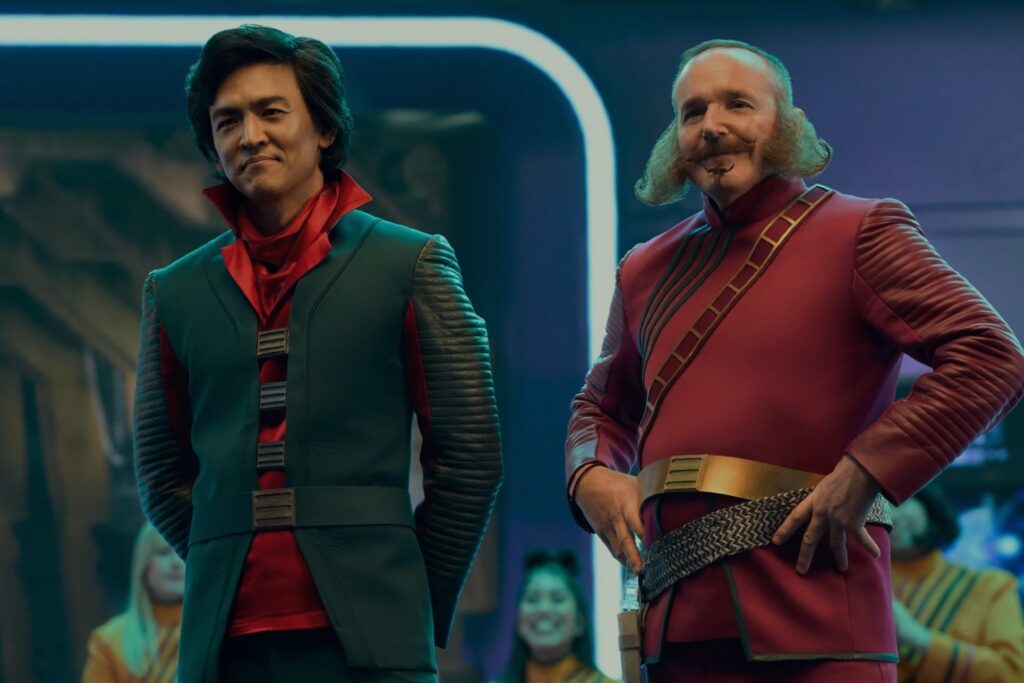If you’ve been watching Murderbot on Apple TV+—and if you haven’t, time to get started; episode four drops Friday!—you’ve no doubt picked up on one of the main character’s most charming quirks: it’s addicted to the galaxy’s trashiest TV.
That might seem like an unlikely time-waster for a self-aware security robot that’s secretly hacked its consciousness and gained free will. But Murderbot‘s SecUnit loves nothing more than using its high-tech capabilities to consume thousands of hours of sci-fi soap operas, especially The Rise and Fall of Sanctuary Moon.
It’s a trait written into the Martha Wells source novel All Systems Red, the first of her Murderbot Diaries series, but the Apple TV+ show has had a delightful time expanding that part of the story so far.
The show-within-a-show features some recognizable faces from other genre shows (including Star Trek‘s John Cho and Agents of SHIELD‘s Clark Gregg, deliberate casting choices). And while Sanctuary Moon‘s neon-drenched space travels are far campier than Murderbot’s day-to-day routine alongside a human survey team on a desolate planet, the fictional hijinks seen on Sanctuary Moon actually influence the character in making some high-stakes choices.
The shows it binges—it’s also a fan of other titles, including World Hoppers, Med Center Argala, and Strife in the Galaxy, which it deems “not premium quality like Sanctuary Moon, but still fun”—also help shape Murderbot’s perspective on humans, as well as its interactions with them. Even those on his team who don’t openly disdain Sanctuary Moon would be surprised to realize how often he peppers lines from the show into conversations.

Though in-universe TV shows are used to particularly good effect on Murderbot, the use of a “show within a show” in tandem with the main narrative is a familiar trope. It’s fun to be fans of characters who also happen to be huge fans of things—think Community‘s knowingly blatant Doctor Who rip-off, Inspector Spacetime. Good-natured self-parody is welcome, too, like when Stargate SG-1 went behind the scenes of Wormhole X-Treme!, a suspiciously familiar series created by a former Stargate operative who’d had his memory (mostly) erased. On Twin Peaks, most TVs were tuned into Invitation to Love, an exaggerated version of the sort of nighttime soap opera Twin Peaks used as its own foundational springboard.
There can also be fake TV shows that exist to remind you how great it is that they don’t actually exist. Black Mirror‘s season six episode “Joan Is Awful” followed a woman who realizes her rather unexciting life is being made into a TV show against her wishes—then discovered she’s wrapped up in a simulation with so many layers it’s hard to see where reality actually starts and ends. Similarly, Channel Zero‘s first season, Candle Cove, concerned a long-forgotten kid’s program that broadcasts its way into reality to torment its former viewers as troubled adults.
Fake TV shows have also made their way into movies, with Galaxy Quest representing maybe the greatest and funniest example of sci-fi fandom taken to the extreme. The 1999 cult comedy imagines a Star Trek-like show that aliens misinterpret as being real life, leading them to enlist its aging, disgruntled stars to help them fight an intergalactic battle. Hilarity ensues, as do some very unlikely heroics.
Last year, another exploration of just how large a single TV show can loom came in I Saw the TV Glow, an eerie fantasy about two friends who bond over their obsession with eerie fantasy series The Pink Opaque. The events of the show come to influence and infiltrate their adult lives, and the end result explores not just the magic of fandom, but also how the strong grip of nostalgia can become twisted into something uneasy and dangerous.
Murderbot doesn’t dig that deeply. It’s focused on entertaining the hell out of you, and in that it succeeds. But there’s more to The Rise and Fall of Sanctuary Moon than gaudy costumes and facial hair. It adds some welcome visual texture to a show that spends a lot of time inside its main character’s mind. It’s a reminder to ignore anyone who snarks on the stuff you happen to like. And it’s a testament to the power of sci-fi, made even more enjoyable when a sci-fi character is also a sci-fi fan. To quote Sanctuary Moon: “Boldness is all!”
Murderbot drops new episodes Fridays on Apple TV+.
Want more io9 news? Check out when to expect the latest Marvel, Star Wars, and Star Trek releases, what’s next for the DC Universe on film and TV, and everything you need to know about the future of Doctor Who.

